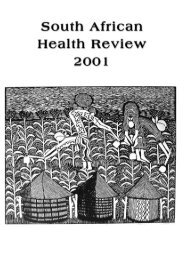The Status of Clinic Committees in Primary Level - Health Systems ...
The Status of Clinic Committees in Primary Level - Health Systems ...
The Status of Clinic Committees in Primary Level - Health Systems ...
Create successful ePaper yourself
Turn your PDF publications into a flip-book with our unique Google optimized e-Paper software.
<strong>The</strong> low level <strong>of</strong> local councillor representation (45%) illustrates that whilst a significant number <strong>of</strong> cl<strong>in</strong>ics<br />
comply with the legislative imperative <strong>of</strong> hav<strong>in</strong>g a cl<strong>in</strong>ic committee, there is limited compliance with the f<strong>in</strong>er<br />
details <strong>of</strong> the legislation as regards composition <strong>of</strong> cl<strong>in</strong>ic committees. Baez and Barron (2006) suggest that one<br />
reason for this poor translation <strong>of</strong> policy <strong>in</strong>to practice is that policy implementation <strong>of</strong>ten takes place at district<br />
level which leaves it vulnerable to the discretion and <strong>in</strong>terpretation <strong>of</strong> the staff at district level. Indeed, they note<br />
that it is at district level where the failure or success <strong>of</strong> community participatory structures are decided through<br />
the existence <strong>of</strong> supportive and effective district level policies and commitment to the process.<br />
Transparent and fair policies and procedures for be<strong>in</strong>g nom<strong>in</strong>ated and appo<strong>in</strong>ted onto governance structures<br />
which are developed <strong>in</strong> conjunction with community representatives and are widely publicized will assist <strong>in</strong><br />
ensur<strong>in</strong>g uniformity <strong>in</strong> the appo<strong>in</strong>tment <strong>of</strong> cl<strong>in</strong>ic committee members. <strong>The</strong>se policies and procedures should<br />
be available and displayed <strong>in</strong> every health facility – <strong>in</strong> a language that is accessible to the local community. In<br />
addition, clarity is also required on the geographical jurisdiction <strong>of</strong> such structures as the National <strong>Health</strong> Act<br />
stipulates that prov<strong>in</strong>cial legislation must at least provide for the establishment <strong>of</strong> a committee for a cl<strong>in</strong>ic or a<br />
group <strong>of</strong> cl<strong>in</strong>ics. Clarity on whether committees are to be set up for <strong>in</strong>dividual cl<strong>in</strong>ics or groups <strong>of</strong> cl<strong>in</strong>ics will<br />
assist <strong>in</strong> clarify<strong>in</strong>g and ref<strong>in</strong><strong>in</strong>g the nom<strong>in</strong>ation and appo<strong>in</strong>tment processes as well the terms <strong>of</strong> reference for the<br />
committees.<br />
It is likely that that the poorest groups do not rout<strong>in</strong>ely participate <strong>in</strong> community activities and steps must<br />
be taken to ensure that these groups together with other vulnerable groups such as women and youth are<br />
represented on governance structures. A failure to do this will result <strong>in</strong> the composition <strong>of</strong> governance structures<br />
resembl<strong>in</strong>g exist<strong>in</strong>g power relations which has the potential to re<strong>in</strong>force and perpetuate exist<strong>in</strong>g <strong>in</strong>equities.<br />
<strong>The</strong> National <strong>Health</strong> Act also makes provision for the head <strong>of</strong> the health facility to serve as a member <strong>of</strong> the<br />
cl<strong>in</strong>ic committee. This has not been borne out by the study and none <strong>of</strong> the facility staff attended any <strong>of</strong> the<br />
meet<strong>in</strong>gs held with cl<strong>in</strong>ic committee members. This attitude <strong>of</strong> see<strong>in</strong>g themselves as separate from the cl<strong>in</strong>ic<br />
committee was also evident <strong>in</strong> Boulle’s (2007) study which she described as follows:<br />
Focus group participants discussed health facility staff <strong>in</strong>volvement as ‘supportive’ <strong>of</strong> the<br />
structures. <strong>The</strong>y described CHC meet<strong>in</strong>gs with health facility staff, as though the staff was<br />
outsiders and they, CHC members, were grateful for their support (Boulle, 2007:57).<br />
5.4 Individualised activities versus a primary health care approach<br />
<strong>The</strong> adoption <strong>of</strong> the <strong>Primary</strong> <strong>Health</strong> Care (PHC) Approach at Alma Ata <strong>in</strong> 1978 was considered a major victory<br />
for health activists who took a broader, multi-sectoral approach to health and health care.<br />
<strong>The</strong> basic philosophy <strong>of</strong> PHC was the “development <strong>of</strong> a comprehensive health strategy that not only provided<br />
health services but also addressed the underly<strong>in</strong>g social, economic and political causes <strong>of</strong> poor health” (Werner<br />
and Sanders, 1997: 18).<br />
Under the rubric <strong>of</strong> a primary health care approach, participatory <strong>in</strong>itiatives such as governance structures<br />
are meant to be <strong>in</strong>volved <strong>in</strong> the plann<strong>in</strong>g, prioritiz<strong>in</strong>g and manag<strong>in</strong>g <strong>of</strong> health services; contribut<strong>in</strong>g to the<br />
development <strong>of</strong> district health plans and the budget<strong>in</strong>g processes and actively partner<strong>in</strong>g with health facility staff<br />
to strategically guide the operation <strong>of</strong> the cl<strong>in</strong>ic to make it more responsive to the needs <strong>of</strong> the local community<br />
(Oakley 1989; Baum and Kahssay, 1999, Baez and Barron, 2006). <strong>The</strong> White Paper for the Transformation <strong>of</strong><br />
the <strong>Health</strong> System <strong>in</strong> South Africa (1997) for example, explicitly outl<strong>in</strong>es a role for governance structures <strong>in</strong> “the<br />
plann<strong>in</strong>g and provision <strong>of</strong> health services” (Department <strong>of</strong> <strong>Health</strong>, 1997: 20). However current practice has not<br />
adhered to the spirit and <strong>in</strong>tention <strong>of</strong> such policy documents.<br />
<strong>Cl<strong>in</strong>ic</strong> committees were <strong>in</strong>volved <strong>in</strong> a range <strong>of</strong> activities, yet these activities do not appear to be l<strong>in</strong>ked to any<br />
broader <strong>in</strong>tegrated primary health care approach and appear rather to take place on a more ad-hoc, irregular<br />
basis. <strong>The</strong>y appear to be fulfill<strong>in</strong>g narrow, mediatory and watchdog functions rather than display<strong>in</strong>g a sense <strong>of</strong><br />
agency <strong>in</strong> tackl<strong>in</strong>g the root causes <strong>of</strong> ill health.<br />
48
















